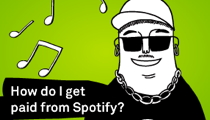This website uses cookies so that we can provide you with the best user experience possible. Cookie information is stored in your browser and performs functions such as recognising you when you return to our website and helping our team to understand which sections of the website you find most interesting and useful.
Business News Digital Top Stories
Spotify launches new resource for artists, hopes to shut up Thom Yorke
By Chris Cooke | Published on Tuesday 3 December 2013
Spotify has more often been in the news this year for the wrong reasons, with the streaming music company, as the highest profile platform of its type in Europe, coming in for a kicking from those artists who have problems with the subscription service business model, mainly on the basis the royalties paid out are tiny.
Of course in many ways, for Spotify’s owners, it doesn’t matter if Thom Yorke, David Byrne et al are dissing their service, given that the labels, in the main, are very pro the business (partly because many of them have equity in the firm, partly because across a wider catalogue the revenues are pretty good). A few angry artists, therefore, have had next to no impact on Spotify’s access to content.
Though, when a key part of your business plan is convincing Wall Street that you’re “the future of music” (an IPO or big sale presumably now on the agenda), it’s embarrassing having big name artists telling everyone how evil you are. I mean, what if the crucial analysts advising idiot investors when a Spotify IPO occurs are all Radiohead and Talking Heads fans? And you know what, not that it will please Yorke or Byrne much, but lots of them probably are.
So Spotify has been busy behind the scenes trying to placate the artist community. Of course, as Spotify, like most players in the streaming music space, is loss making, and already handing over the majority of its revenue to the rights owners, it can’t increase the royalty pay outs. And it can’t do anything about the record contracts that are partly behind the miniscule royalty cheques some artists are receiving from Spotify et al.
But the company could be more transparent. And it could give artists some of that new fuel that is powering the industry: data. And it could look to help acts up-sell products beyond recorded music. And look, Spotify’s doing all three with the launch today of Spotify Artists, a new website aimed at the artistic community.
The Spotify Artists site provides guidelines for artists and managers on how the streaming service works, what royalties are paid, and how featured artists can get more out of the platform, even if their content is being provided to the digital firm via a label. Perhaps more importantly, the new service also includes an artist dashboard created in partnership with Next Big Sound to help artists capture all sorts of real time data about how their music is performing on the streaming set up (in addition to the Musicmetric-powered data service already available to labels).
And on top of all that, Spotify says it has grand plans to turn its streaming player into an up-sell platform to help artists sell more of the things that make them money beyond records, ie mainly merchandise and tickets. An existing partnership with Songkick is fuelling the latter, while a new alliance with Topspin will enable the former. And Spotify isn’t planning on taking a cut from any of that sell-through.
Although the data provision and up-sell facilities are in reality more important, the insights into how Spotify’s royalty payments work will probably generate the most initial interest amongst those who didn’t previously have access to this information. The per-play payout is between $0.006 and $0.0084 says the streaming service, though Spotify is keen to steer artists away from talking about per-play payments to instead think about how much an album could generate on a monthly basis.
According to the new site, in July this year a “niche indie album” was generating $3,300 in monthly income from Spotify, while the pay out for a “global hit album” was $425,000. And if Spotify ever reached 40 million paying subscribers, the firm’s Director Of Artist Services Mark Williamson has told the Guardian, those figures would jump up to $17,000 a month for the niche indie title and $2 million a month for the global superstar. We (ie artists too) all benefit if we can make Spotify listening the norm, is the implication.
On the motivation behind Spotify Artists, Williamson adds: “The position we take is, look, we know Spotify is not perfect for all artists yet, but this is the theory behind it, this is where we are, and this is where we’re going. With any format change in music – CD and iTunes included – there’s a lot of confusion around how these different models work, and quite often some serious scepticism. We understand that’s out there, so we want to be as clear and transparent as we possibly can explaining how Spotify fits in”.
Whether any of this placates Yorke, Byrne et al remains to be seen. For featured artists, it should address some of the concerns, and could well reposition the debate. Though much of this summer’s Spotify bashing was kicked off by Nigel Godrich, first and foremost a producer, and those record producers and songwriters who do not have a consumer-facing brand may not be so easily placated.
Unfortunately for the streaming companies though, that’s an issue that can only really be resolved by a battle between the labels and the publishers about the slightly skewed way in which the digital royalties split (between recording and song rights owners) has been engineered to the benefit of the former. And that’s a battle Spotify et al can’t fight.






